| Columns Retired Columns & Blogs |
Oh! to have $304k to spend on such a system!!
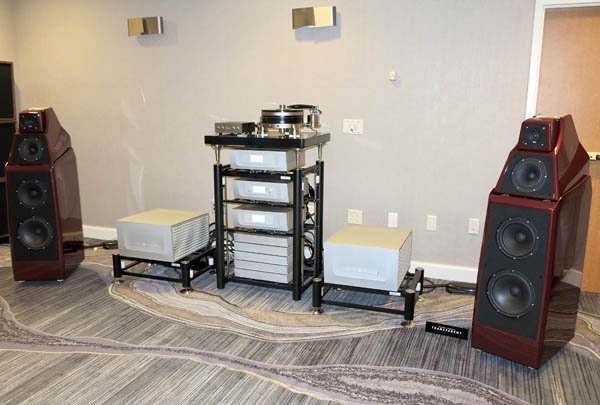
While it's often associated with classical music, the Alexia 2 drew strong, downright nasty bass from a Stevie Ray Vaughan LP. Although someone complained to me on the last day of the show that blues rocker Vaughan had replaced The Eagles as the default rock source for multiple exhibitors, I was too blown away by his sound on this system to care.
Constellation Audio equipment has a different, darker cast than the VTL and Dan D'Agostino electronics with which I'm accustomed to hearing Wilson loudspeakers, but their control is absolute. Over and over again, I got the sense that nothing could possibly phase this system.
Feeding the Alexia 2s were the Continuum Audio Labs Obsidian turntable ($35,000) with Viper tonearm ($10,000) and Ortofon A-95 cartridge ($7,000), brand new Roon-ready Constellation Audio Cygnus Media Player/DAC ($38,000), Constellation Audio Perseus phono preamp ($32,000) with DC filter ($6,000), Constellation Audio Virgo III preamp ($32,000) with another DC Filter ($6,000), Constellation Audio Centaur II monoblocks ($80,000/pair), and Transparent Audio power conditioning and cables. Supporting most of the components was an Artesania rack.
This setup awed with its ability to perfectly articulate a recording's every macro and micro detail. After Wilson's Peter McGrath switched from LP to file playback, the size and visceral impact of a piano and cello playing a transcription of Oscar Strauss's beguiling song, "Je t'aime", seemed realistic, and bass textures were superb. Similarly, the power and range of Virgil Fox's organ on his final recital, from 1972, was absolutely convincing. On a smaller scale, listening to Renée Fleming, Elly Ameling, and Lorraine Hunt Lieberson became an enlightening experience, because I felt I could hear the soul that each artist was pouring into her performance.
While the original, 4 ohm Alexia's bass impedance drops to 1.5 ohms, the Alexia 2's bass impedance dips no lower than 2.8 ohms. This means that Alexia 2 will present a significantly easier load to amplification, and be friendlier to the amps that may come my way for review. I can't wait to hear the Alexia 2s in my reference system.
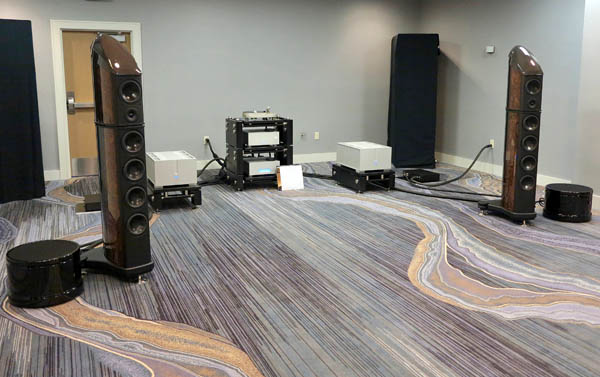
Brian Ackerman's Aaudio Imports paired impressive (and impressively costly) Ypsilon electronics with Wilson Benesch's flagship Cardinal loudspeakers ($114,500/pair). From Ypsilon came the Hyperion mono amps ($93,000), the Stereophile Class A PST-100 MKII valve preamp ($37,000), Stereophile Class A+ VPS-100 valve phono stage ($26,000), and MC26L step-up transformer ($6,200). Also in the system: Thales TTT Compact II turntable ($14,500) with a new Statement tonearm ($21,000) that lacked sufficient break-in, and an Ikeda Kai MC cartridge ($8500); Wilson Benesch's Torus + amp infrasonic generator ($12,500) and R1 Carbon modular rack ($25,500); and an HB Cable Design PowerSlave marble power distributor ($13,500) anchoring Stage III cabling.
Alas, perhaps because the tonearm and the 250-lb amps were brand new—the amps lacked the claimed 1000 hours of break-in (!) their silver windings need to sound their best—highs were a bit metallic, bass a mite loose, and warmth not the system's strong point. Size and impact, on the other hand, certainly were.
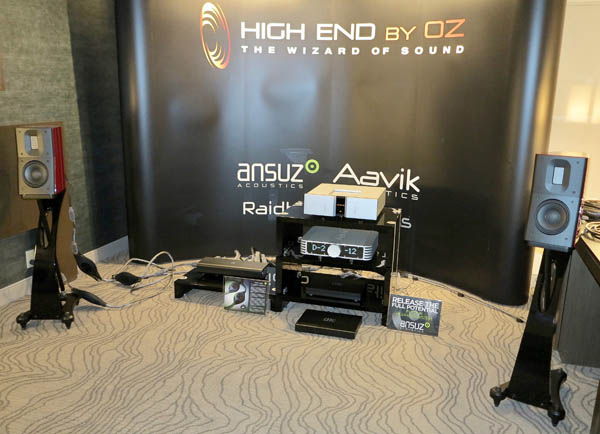
High End by Oz—a fitting name for an audio dealership based in La-La land—paved its yellow brick road with Raidho D1.1 loudspeakers in Ferrari Fiorano Red with adjustable diamond feet ($38,000/pair), the new Aavik Acoustics U-150 integrated amplifier with optional DAC and phono stage ($20,400 total), Vitus Audio Masterpiece MP-T201MKII CD transport ($21,600), Ansuz Acoustics cables (ranging between $10,600 and $32,000), and Raidho racks ($1700 per level). Although the bottom end was not fully under control in the small space, tonalities were lovely.
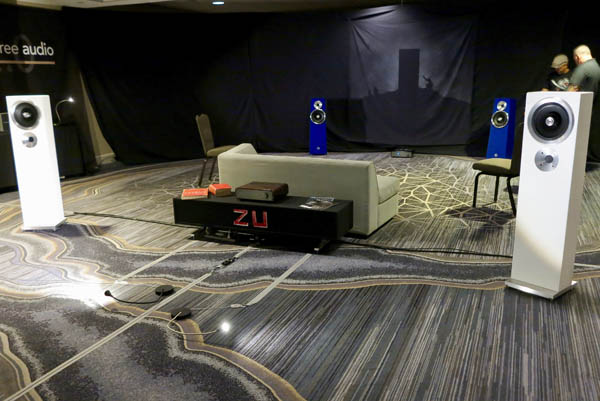
In a large space that included a live DJ spinning multiple platters, Zu Audio and Peachtree set up two very different systems. The big system (pictured) had the Peachtree nova300 integrated amp ($2500) driving new Zu Druid-VI loudspeakers ($10,000/pair) and Zu Undertone subs ($2500/each) via Zu Event cabling ($3000 total). I didn't get the names of tables and cartridges, but given how much better both wired and wireless file playback sounded, it was just as well.
With files sourced from a hidden computer and played via an iPad, bass, soundstage width and height, and impressive three-dimensionality made for a winning presentation. This was a really dynamic system that nailed the size and texture of a trumpet. Yes, there was a bit of grayness to the sound, but a live recording of the Hadock Trio had such a fine midrange, with excellent bite on top, that it was easy to overlook the lack of ultimate transparency.
Turning 180° as fast as I could—it's hard to keep up with David Solomon when he's on a roll—I heard Peachtree's wireless/wired decco125 SKY ($1199) paired with Zu Omen loudspeakers ($1000/pair). When David cued up Malia and Boris Blank's "Celestial Echo," control and color were so good that they immediately identified this great sounding Peachtree/Zu pairing as one of the bargain finds of RMAF 2017.
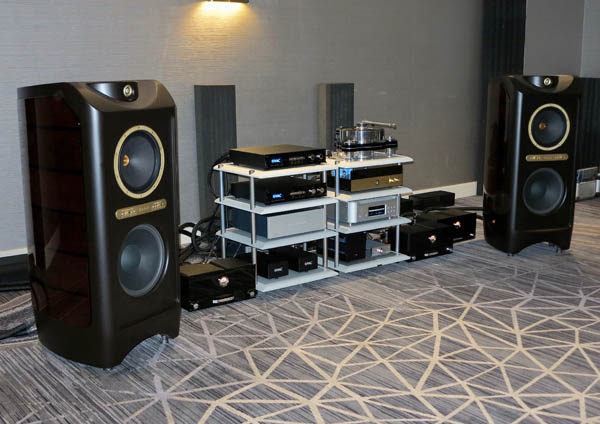
On Friday afternoon, when I visited VAC's familiar hangout in the Maroon Peak room on the Marriott Tower's mezzanine level, the company's pairing with Transrotor, Esoteric, Tannoy, and Shunyata had yet to iron out all the kinks. Hence, rather than dwell on the system's lovely but surprisingly toned-down top—not at all what I expected—I'll note that after I left, a failing phono cartridge was replaced with an AirTight PC-1 Supreme, and the Tannoy Kingdom Royal Mk II speakers ($96,000/pair) were adjusted to open up the top end more and improve overall balance and life. Even so, it was possible to discern that an old, discontinued VAC DAC Mk II from 1993 ($4990 way back then) exhibited far more openness on top and a greater range of colors than the much newer Esoteric K-03 CD player ($11,650 in 2014).
Doing their best under the circumstances were the VAC Renaissance phono stage ($9900), Renaissance Mk V line stage ($9990) with optional internal phono stage ($3000), and Signature 200 iQ power amplifiers ($14,000/each); Transrotor Rondino Nero turntable ($14,000) with 5012 tonearm ($5500); TAOC ASR-4 Silver rack ($4000); and Shunyata Triton and Typhon power distribution plus their Anaconda cabling.
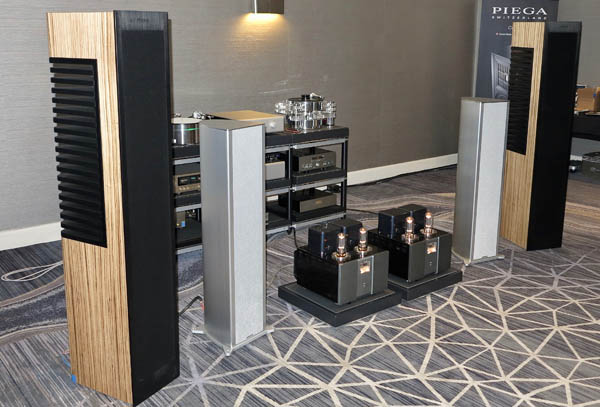
In a system, from Apex Audio of Denver, that sounded as good as it looked, the US debut of the Piega MLS 2 Master Linesource loudspeakers ($88,000/pair)—the smaller Piega Coax 711 speakers ($25,000/pair) were not playing during my visit—joined Air Tight's ATE 2001 Reference preamp ($30,000) and Push Pull Monos ($70,000/pair). It sure didn't hurt that a Soulution 560 DAC ($35,000) and Olasonic CD-1 upsampling transport (approx. $585—that is not a typo) joined other components on Critical Mass Systems Qxk racks and stands ($2995 per component) and Pitch Perfect Sound Center Stage audio feet ($300 each). Before someone screams bloody murder because I don't mention the cabling, please be informed that the supplied equipment list sins similarly.
I wish I could say more about this system, but at 6:00 PM, after going room-to-room since 10:15 AM, I had just enough time to grab something to eat before heading to the Hilton for the third annual Rocky Mountain International HiFi Press Awards (RIHPA). Far better organized than last year's installment, the awards deserve a blog all their own.

Oh! to have $304k to spend on such a system!!

Excellent coverage! JVS